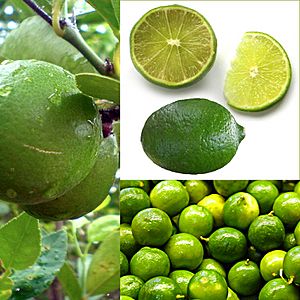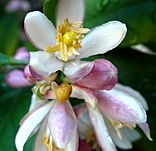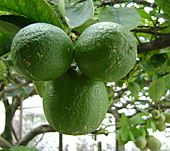Lime production in Mexico facts for kids
Mexico is a huge player in the world of limes! For many years, since the 1950s, Mexico has been the biggest producer and exporter of limes and lime oil globally.
Two main types of limes grow in Mexico. One is the Mexican lime, also known as the Key lime (Citrus aurantifolia). This lime came from Asia and was brought to Mexico by the Spaniards after the 1520s. The other type is the Persian lime (Citrus latifolia), which is also called the Tahiti lime. This one came from the United States.
Mexico grows a lot of Persian limes especially for the US market. The amount of limes grown has increased a lot, partly because of the North American Free Trade Agreement. People in the United States and the European Union (EU) are also eating more limes, which has helped Mexico's lime production grow even more.
Contents
Where Limes Grow in Mexico
Most limes in Mexico are grown in the warmer parts of the country. About 60% come from the southwest, and 40% from the southeast.
Key limes make up about 54% of all limes grown. You can find them in southwestern states like Jalisco, Colima, Michoacán, Guerrero, and Oaxaca.
Persian limes account for about 42% of the total lime production. They are grown in states such as Jalisco, Colima, Hidalgo, and parts of northern Veracruz. You'll also find them in southeastern states like Tlaxcala, Chiapas, Tabasco, and Yucatan. The states that produce the most limes are Michoacán and Colima.
Types of Limes Grown in Mexico
Key Lime Characteristics
The Key lime tree is often called the "Mexican lime." It is a thin tree that usually grows to be about 2 to 4 meters (6.5 to 13 feet) tall. Its flowers do not have a strong smell. They have white stems and yellow parts called anthers.
The fruit grows alone, in pairs, or in bigger groups. Key limes are usually 25 to 51 millimeters (1 to 2 inches) wide. As they get ripe, their skin changes from green to a light yellow color. The inside of the fruit is greenish-yellow and has 6 to 15 parts. It is very juicy and tastes quite sour, with a strong flavor and smell. It can have a few or many small seeds.
Key lime trees like moist weather with a lot of rain. However, they can handle dry conditions better than other citrus fruits. If there is too much rain, the trees might get sick from fungus. Key limes are also sensitive to cold weather. They need to be grown in places where they are protected from the cold.
Key limes stay fresh longer than other limes. This is helpful because not all places in Mexico have good refrigeration. Spanish explorers brought this tree from Asia to Mexico after the year 1520. Today, there are about 2 million young Key lime trees near Colima. There are not many different kinds of Key limes, as they do not change much in the wild or when grown on farms.
Persian Lime Characteristics

Persian limes are bigger and have more juice than Key limes. This type of sour lime was developed more recently. Scientists think it is a hybrid of the Key lime and the citron.
The Persian or Tahiti lime tree grows to be about 4.5 to 6 meters (15 to 20 feet) tall. It has wide, pointed leaves and flowers that are slightly purple. These flowers usually appear in January and do not have good pollen. The fruit has bright green skin until it ripens to a pale yellow. The inside of the fruit has 10 parts that are light greenish-yellow. It usually does not have any seeds.




